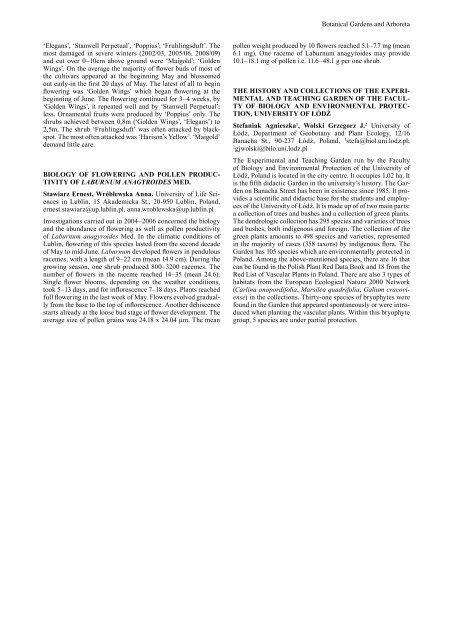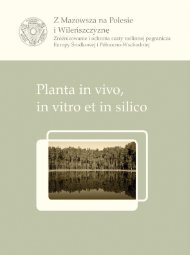acta societatis botanicorum poloniae - LV Zjazd Polskiego ...
acta societatis botanicorum poloniae - LV Zjazd Polskiego ...
acta societatis botanicorum poloniae - LV Zjazd Polskiego ...
Create successful ePaper yourself
Turn your PDF publications into a flip-book with our unique Google optimized e-Paper software.
‘Elegans’, ‘Stanwell Perpetual’, ‘Poppius’, ‘Fruhlingsduft’. The<br />
most damaged in severe winters (2002/03, 2005/06, 2008/09)<br />
and cut over 0– 10cm above ground were ‘Maigold’; ‘Golden<br />
Wings’. On the average the majority of flower buds of most of<br />
the cultivars appeared at the beginning May and blossomed<br />
out early-in the first 20 days of May. The latest of all to begin<br />
flowering was ‘Golden Wings’ which began flowering at the<br />
beginning of June. The flowering continued for 3– 4 weeks, by<br />
‘Golden Wings’, it repeated well and by ‘Stanwell Perpetual’;<br />
less. Ornamental fruits were produced by ‘Poppius’ only. The<br />
shrubs achieved between 0,8m (‘Golden Wings’, ‘Elegans’) to<br />
2,5m. The shrub ‘Fruhlingsduft’ was often attacked by blackspot.<br />
The most often attacked was ‘Harison’s Yellow’. ‘Maigold’<br />
demand little care.<br />
BIOLOGY OF FLOWErING ANd POLLEN PrOdUC-<br />
TIVITY OF lAburnum AnAGyroides MEd.<br />
Stawiarz Ernest, Wróblewska Anna. University of Life Sciences<br />
in Lublin, 15 Akademicka St., 20-950 Lublin, Poland,<br />
ernest.stawiarz@up.lublin.pl, anna.wroblewska@up.lublin.pl<br />
Investigations carried out in 2004– 2006 concerned the biology<br />
and the abundance of flowering as well as pollen productivity<br />
of Laburnum anagyroides Med. In the climatic conditions of<br />
Lublin, flowering of this species lasted from the second decade<br />
of May to mid-June. Laburnum developed flowers in pendulous<br />
racemes, with a length of 9– 22 cm (mean 14.9 cm). During the<br />
growing season, one shrub produced 800– 3200 racemes. The<br />
number of flowers in the raceme reached 14– 35 (mean 24.6).<br />
Single flower blooms, depending on the weather conditions,<br />
took 5– 13 days, and for inflorescence 7– 18 days. Plants reached<br />
full flowering in the last week of May. Flowers evolved gradually<br />
from the base to the top of inflorescence. Another dehiscence<br />
starts already at the loose bud stage of flower development. The<br />
average size of pollen grains was 24.18 x 24.04 µm. The mean<br />
Botanical Gardens and Arboreta<br />
pollen weight produced by 10 flowers reached 5.1– 7.7 mg (mean<br />
6.1 mg). One raceme of Laburnum anagyroides may provide<br />
10.1– 18.1 mg of pollen i.e. 11.6– 48.1 g per one shrub.<br />
THE HISTOrY ANd COLLECTIONS OF THE ExPErI-<br />
MENTAL ANd TEACHING GArdEN OF THE FACUL-<br />
TY OF BIOLOGY ANd ENVIrONMENTAL PrOTECtIoN,<br />
UNIvERSIty of ŁóDź<br />
Stefaniak Agnieszka 1 , Wolski Grzegorz J. 2 University of<br />
Łódź, Department of Geobotany and Plant Ecology, 12/16<br />
Banacha St., 90-237 Łódź, Poland, 1 stefa@biol.uni.lodz.pl;<br />
2 gjwolski@bilo.uni.lodz.pl<br />
The Experimental and Teaching Garden run by the Faculty<br />
of Biology and Environmental Protection of the University of<br />
Łódź, Poland is located in the city centre. It occupies 1,02 ha. It<br />
is the fifth didactic Garden in the university’s history. The Garden<br />
on Banacha Street has been in existence since 1985. It provides<br />
a scientific and didactic base for the students and employees<br />
of the University of Łódź. It is made up of of two main parts:<br />
a collection of trees and bushes and a collection of green plants.<br />
The dendrologic collection has 295 species and varieties of trees<br />
and bushes; both indigenous and foreign. The collection of the<br />
green plants amounts to 498 species and varieties, represented<br />
in the majority of cases (358 taxons) by indigenous flora. The<br />
Garden has 105 species which are environmentally protected in<br />
Poland. Among the above-mentioned species, there are 16 that<br />
can be found in the Polish Plant Red Data Book and 18 from the<br />
Red List of Vascular Plants in Poland. There are also 3 types of<br />
habitats from the European Ecological Natura 2000 Network<br />
(Carlina onopordifolia, Marsilea quadrifolia, Galium cracoviense)<br />
in the collections. Thirty-one species of bryophytes were<br />
found in the Garden that appeared spontaneously or were introduced<br />
when planting the vascular plants. Within this bryophyte<br />
group, 5 species are under partial protection.



